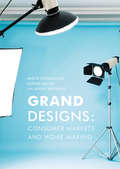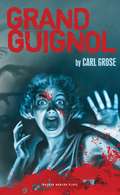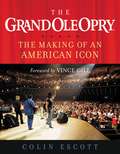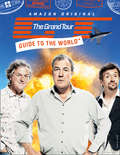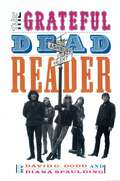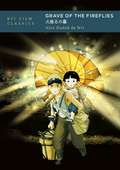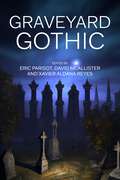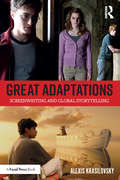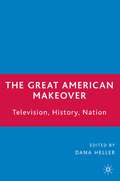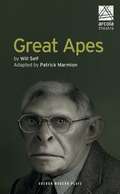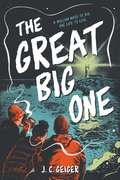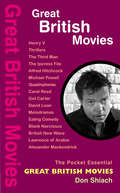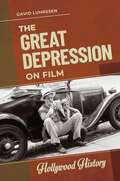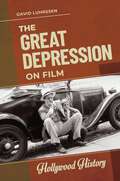- Table View
- List View
Grand Design: Hollywood As A Modern Business Enterprise, 1930-1939 (pdf) (History Of American Cinema Ser. #Vol. 5)
by Tino BalioThe advent of color, big musicals, the studio system, and the beginning of institutionalized censorship made the thirties the defining decade for Hollywood. The year 1939, celebrated as "Hollywood's greatest year," saw the release of such memorable films as Gone with the Wind, The Wizard of Oz, and Stagecoach. It was a time when the studios exercised nearly absolute control over their product as well as over such stars as Bette Davis, Clark Gable, and Humphrey Bogart. In this fifth volume of the award-winning series History of the American Cinema, Tino Balio examines every aspect of the filmmaking and film exhibition system as it matured during the Depression era.
Grand Designs: Consumer Markets and Home-Making
by Aneta Podkalicka Esther Milne Jenny KennedyThis is the first academic book to examine the long running hit series Grand Designs, which occupies a significant place in the popular imagination internationally. The authors apply an empirically grounded, critical perspective to the study of television to reveal how people use the program in their everyday lives. The emphasis on everyday uses and meanings combines creatively with understanding the program theoretically, textually and in terms of its production structures. This position challenges framings of the popular lifestyle and factual television genre that has been dominated by a neoliberal or governmentality perspective for many years. Presented by British designer and writer, Kevin McCloud, Grand Designs follows the progress of home owners as they embark on design, renovation and building projects at almost always dizzying scales of endeavour. Understanding the program as both a text to analyse and a site of material impact, the book draws on interviews with production members, home renovators, building practitioners and audiences, as well as references to associated media formats to provide contextual depth to the analysis. The authors argue that, as a cultural object, the program is both shaped by and enacts social discourses of home-making, design value and taste. Navigating public, commercial and promotional logics, Grand Designs sparks new forms of cultural production and consumer markets.
Grand Guignol (Oberon Modern Plays)
by Carl Grose1903. In the back streets of Montmartre, the Theatre du Grand Guignol opens its doors to an unsuspecting public. The plays performed, rife with madness and murder, are sold out every night. A psychiatrist obsessed with the playwright’s gruesome dramas ingratiates his way into the company. But when he starts to unpick the author’s mind, the boundaries between theatre and truth begin to blur… Delighting in this lost theatrical form, Carl Grose’s demented new play works fast and loose with convention. A black comedy, a psychological thriller and an unrepentant splatterfest, Grand Guignol is a head-spinning, genre-bending phantasmagoria guaranteed to keep you guessing (and wincing) to the very last horror show…
The Grand Ole Opry: The Making of an American Icon
by Colin EscottThis official guide chronicles the story of the birthplace of country music as told by the people who were there. Escott presents the official inside history of the home of country music, offering fans an exclusive look into the heart and soul of country music. Full color, and packed with photos from the Opry Archives covering 80 years of history.
The Grand Tour Guide to the World
by HarperCollinsThe world is a big place full of interesting things. And The Grand Tour has seen some of them. That’s why few people are better placed to lead you around this vast planet of ours than Jeremy Clarkson, Richard Hammond and James May. As long as you don’t mind getting hot and lost. Welcome, everyone, to The Grand Tour Guide to The World.
The Grateful Dead Reader (Readers on American Musicians)
Arranged in chronological order, these pieces add up to nothing less than a full-scale history of the greatest tour band in the history of rock. From Tom Wolfe's account of the Dead's first performance as the Grateful Dead (at an Acid Test in 1965), to Ralph Gleason's 1967 interview with the 24-year-old Jerry Garcia, to Mary Eisenhart's obituary of the beloved leader of the band, these selections include not only outstanding writing on the band itself, but also superb pieces on music and pop culture generally. Fans will be fascinated by the poetry, fiction, drawings, and rare and revealing photographs featured in the book, as well as the anthology's many interviews and profiles, interpretations of lyrics, and concert and record reviews. Still, The Grateful Dead was more than a band--it was a cultural phenomenon. For three decades it remained on one unending tour, followed everywhere by a small army of nomadic fans. This phenomenon is both analyzed and celebrated here, in such pieces as Ed McClanahan's groundbreaking article in Playboy in 1972, fan-magazine editor Blair Jackson's 1990 essay on the seriousness of the drug situation at Dead concerts, and Steve Silberman's insightful essays on the music and its fans.
Grave of the Fireflies (BFI Film Classics)
by Alex Dudok WitOn its release in 1988, Grave of the Fireflies riveted audiences with its uncompromising drama. Directed by Isao Takahata at Studio Ghibli and based on an autobiographical story by Akiyuki Nosaka, the story of two Japanese children struggling to survive in the dying days of the Second World War unfolds with a gritty realism unprecedented in animation. Grave of the Fireflies has since been hailed as a classic of both anime and war cinema. In 2018, USA Today ranked it the greatest animated film of all time. Yet Ghibli's sombre masterpiece remains little analysed outside Japan, even as its meaning is fiercely contested - Takahata himself lamented that few had grasped his message. In the first book-length study of the film in English, Alex Dudok de Wit explores its themes, visual devices and groundbreaking use of animation, as well as the political context in which it was made. Drawing on untranslated accounts by the film's crew, he also describes its troubled production, which almost spelt disaster for Takahata and his studio.
Grave of the Fireflies (BFI Film Classics)
by Alex Dudok WitOn its release in 1988, Grave of the Fireflies riveted audiences with its uncompromising drama. Directed by Isao Takahata at Studio Ghibli and based on an autobiographical story by Akiyuki Nosaka, the story of two Japanese children struggling to survive in the dying days of the Second World War unfolds with a gritty realism unprecedented in animation. Grave of the Fireflies has since been hailed as a classic of both anime and war cinema. In 2018, USA Today ranked it the greatest animated film of all time. Yet Ghibli's sombre masterpiece remains little analysed outside Japan, even as its meaning is fiercely contested - Takahata himself lamented that few had grasped his message. In the first book-length study of the film in English, Alex Dudok de Wit explores its themes, visual devices and groundbreaking use of animation, as well as the political context in which it was made. Drawing on untranslated accounts by the film's crew, he also describes its troubled production, which almost spelt disaster for Takahata and his studio.
Graveyard Gothic
by Eric Parisot, David McAllister and Xavier Aldana ReyesGraveyard Gothic is the first sustained consideration of the graveyard as a key Gothic locale. This volume examines various iterations of the Gothic graveyard (and other burial sites) from the eighteenth century to the twenty-first, as expressed in numerous forms of culture and media including poetry, fiction, TV, film and video games. The volume also extends its geographic scope beyond British traditions to accommodate multiple cultural perspectives, including those from the US, Mexico, Japan, Australia, India and Eastern Europe. The seventeen chapters from key international Gothic scholars engage a range of theoretical frameworks, including the historical, material, colonial, political and religious. With a critical introduction offering a platform for further scholarship and a coda mapping potential future critical and cultural developments, Graveyard Gothic is a landmark volume defining a new area of Gothic studies.
Graveyard Gothic
by Eric Parisot David McAllister Xavier Aldana ReyesGraveyard Gothic is the first sustained consideration of the graveyard as a key Gothic locale. This volume examines various iterations of the Gothic graveyard (and other burial sites) from the eighteenth century to the twenty-first, as expressed in numerous forms of culture and media including poetry, fiction, TV, film and video games. The volume also extends its geographic scope beyond British traditions to accommodate multiple cultural perspectives, including those from the US, Mexico, Japan, Australia, India and Eastern Europe. The seventeen chapters from key international Gothic scholars engage a range of theoretical frameworks, including the historical, material, colonial, political and religious. With a critical introduction offering a platform for further scholarship and a coda mapping potential future critical and cultural developments, Graveyard Gothic is a landmark volume defining a new area of Gothic studies.
Great Adaptations: Strategies For Screenwriters In Today's World
by Alexis KrasilovskyGreat Adaptations: Screenwriting and Global Storytelling is the Second Place Winner in the 2019 International Writers Awards! A vast majority of Academy Award-winning Best Pictures, television movies of the week, and mini-series are adaptations, watched by millions of people globally. Great Adaptations: Screenwriting and Global Storytelling examines the technical methods of adapting novels, short stories, plays, life stories, magazine articles, blogs, comic books, graphic novels and videogames from one medium to another, focusing on the screenplay. Written in a clear and succinct style, perfect for intermediate and advanced screenwriting students, Great Adaptations explores topics essential to fully appreciating the creative, historical and sociological aspects of the adaptation process. It also provides up-to-date, practical advice on the legalities of acquiring rights and optioning and selling adaptations, and is inclusive of a diverse variety of perspectives that will inspire and challenge students and screenwriters alike. Please follow the link below to a short excerpt from an interview with Carole Dean about Great Adaptations: https://fromtheheartproductions.com/getting-creative-when-creating-great-adaptations/
Great Adaptations: Screenwriting and Global Storytelling
by Alexis KrasilovskyGreat Adaptations: Screenwriting and Global Storytelling is the Second Place Winner in the 2019 International Writers Awards! A vast majority of Academy Award-winning Best Pictures, television movies of the week, and mini-series are adaptations, watched by millions of people globally. Great Adaptations: Screenwriting and Global Storytelling examines the technical methods of adapting novels, short stories, plays, life stories, magazine articles, blogs, comic books, graphic novels and videogames from one medium to another, focusing on the screenplay. Written in a clear and succinct style, perfect for intermediate and advanced screenwriting students, Great Adaptations explores topics essential to fully appreciating the creative, historical and sociological aspects of the adaptation process. It also provides up-to-date, practical advice on the legalities of acquiring rights and optioning and selling adaptations, and is inclusive of a diverse variety of perspectives that will inspire and challenge students and screenwriters alike. Please follow the link below to a short excerpt from an interview with Carole Dean about Great Adaptations: https://fromtheheartproductions.com/getting-creative-when-creating-great-adaptations/
The Great American Makeover: Television, History, Nation
by D. HellerThe Great American Makeover is a collection of essays that explore the American makeover mythos that has been recently repackaged in the form of popular makeover television programs such as Extreme Makeover, The Swan, Supernanny, and Queer Eye for the Straight Guy.
Great Apes (Oberon Modern Plays)
by Will Self Patrick Marmion“I want my life back now. Feel human again. Homo erectus.”When Turner Prize-winning artist Simon Dykes wakes up one morning after a wild night out, he finds his world has changed beyond recognition. His girlfriend, Sarah, has turned into a chimpanzee. And to his horror, so has everyone else. Immediately rushed to hospital, Simon is taken into the care of charismatic radical psychiatrist Zack Busner and treated for being under the psychotic delusion that he’s human.This raucous new stage adaptation from Patrick Marmion (The Divided Laing) mixes razor-sharp language with movement and puppetry, journeying into the mystery of what it means to be a human being.
The Great Big One
by J. C. GeigerWith natural disasters and nuclear war threatening their small town, two twin brothers find themselves enraptured by mysterious music that could change the course of their lives.Everyone in Clade City knows their days are numbered. The Great Cascadia Earthquake will destroy their hometown and reshape the entire West Coast—if they survive long enough to see it. Nuclear war is increasingly likely. Wildfires. Or another pandemic. To Griff, the daily forecast feels partly cloudy with a chance of apocalyptic horsemen.Griff&’s brother, Leo, and the Lost Coast Preppers claim to be ready. They&’ve got a radio station. Luminous underwater monitors. A sweet bunker, and an unsettling plan for &“disaster-ready rodents.&” But Griff&’s more concerned about what he can do before the end times. He&’d like to play in a band, for one. Hopefully with Charity Simms. Her singing could make the whole world stop.When Griff, Leo, and Charity stumble upon a mysterious late-night broadcast, one song changes everything. It&’s the best band they&’ve ever heard—on a radio signal even the Preppers can&’t trace. They vow to find the music, but aren&’t prepared for where their search will take them. Or for what they&’ll risk, when survival means finding the one thing you cannot live without.
Great British Movies: The Best British Films to Watch, 1929 - 2005 (A\pocket Essentials Guide Ser.)
by Don ShiachWhich British movies are the best that this country has produced? In this volume Don Shiach encapsulates the peaks of the British film achievement from the beginning of the sound era to the first decade of the 21st century. The giant figures of the 1930s, Alfred Hitchcock and Alexander Korda, set a standard for the domestic film industry in its attempt to challenge the domination of the Hollywood film. Many saw the 1940s as the Golden Age of British cinema with directors such as Carol Reed and Michael Powell leading the way in establishing British cinema as worthy of serious consideration. From then on there were as many troughs as there were triumphs, but the industry continues to produce the odd masterpiece to extend the great tradition. Spanning the period from 1929 to 2005, Great British Movies makes a fascinating read, a useful reference book and a must for all fans of British cinema.
The Great Depression on Film (Hollywood History)
by David LuhrssenThis book presents the Great Depression through the lens of 13 films, beginning with movies made during the Depression and ending with films from the 21st century, and encourages readers to examine the various depictions of this period throughout history.The Great Depression on Film is a unique guide to how the Great Depression was represented and is remembered, making it an excellent resource for students or anyone interested in film history or U.S. history. Each film is set in a different sector of American life, focusing on such topics as white supremacy, political protest, segregation, environmental degradation, crime, religion, the class system, and popular culture in the U.S. during the 1930s.This book is indispensable for clearing away misconceptions fostered by the movies while acknowledging the power of film in shaping public memory. The book separates fact from fiction, detailing where the movies are accurate and where they depart from reality, and places them in the larger context of historical and social events. Eyewitness or journalistic accounts are referenced and quoted in the text to help readers differentiate between ideas, attitudes, and events presented in the films, as well as the historical facts which inspired those films.
The Great Depression on Film (Hollywood History)
by David LuhrssenThis book presents the Great Depression through the lens of 13 films, beginning with movies made during the Depression and ending with films from the 21st century, and encourages readers to examine the various depictions of this period throughout history.The Great Depression on Film is a unique guide to how the Great Depression was represented and is remembered, making it an excellent resource for students or anyone interested in film history or U.S. history. Each film is set in a different sector of American life, focusing on such topics as white supremacy, political protest, segregation, environmental degradation, crime, religion, the class system, and popular culture in the U.S. during the 1930s.This book is indispensable for clearing away misconceptions fostered by the movies while acknowledging the power of film in shaping public memory. The book separates fact from fiction, detailing where the movies are accurate and where they depart from reality, and places them in the larger context of historical and social events. Eyewitness or journalistic accounts are referenced and quoted in the text to help readers differentiate between ideas, attitudes, and events presented in the films, as well as the historical facts which inspired those films.
The Great European Stage Directors Volume 1: Antoine, Stanislavski, Saint-Denis (Great Stage Directors)
by Simon ShepherdThis volume assesses the contributions of André Antoine, Konstantin Stanislavski and Michel Saint-Denis, whose work has influenced theatre and training for over a century. These directors pioneered Naturalism and refined Realism as they experimented with theatrical form including non-Realism. Antoine and Stanislavski's theatre direction proved foundational to the creation of the director's role and artistic vision, and their influential ideas progressively developed through the stylized theatre of Saint-Denis to the innovative contemporary theatre direction of Max Stafford-Clark, Declan Donnellan and Katie Mitchell.
The Great European Stage Directors Volume 2: Meyerhold, Piscator, Brecht (Great Stage Directors)
by David BarnettThis volume surveys and assesses the contributions of Vsevolod Meyerhold, Erwin Piscator and Bertolt Brecht to theatre-making, which richly exemplify the range of ways that directors address dramatic material, theatrical space and their audiences. Their directorial work marks an unmistakeable interest in developing the political potential of theatre in the early 20th century, although each director offered more to their actors, collaborators and spectators than simply the staging of politics and the political.
The Great European Stage Directors Volume 3: Copeau, Komisarjevsky, Guthrie (Great Stage Directors)
by Simon ShepherdThis volume examines the work of directors Jacques Copeau, Theodore Komisarjevsky and Tyrone Guthrie. It explores in detail many of the directors' key productions, including Copeau's staging of Molière's The Tricks of Scapin, Komisarjevsky's signature season of Chekhov plays at the Barnes Theatre and Guthrie's pioneering direction of Shakespeare's plays in North America. This study argues that their work exemplifies the complexity and novelty of the role of theatre directing in the first three-quarters of the 20th century, as Komisarjevsky was in the middle of the genesis of directing in Russia, Copeau launched his directorial career just as the role was gaining definition, and Guthrie was at the vanguard of directing in Britain, at last shaking off the traditions of the actor-manager to formulate the new role of artistic director.
The Great European Stage Directors Volume 4: Reinhardt, Jessner, Barker (Great Stage Directors)
by Simon ShepherdIn this volume leading scholars assess the contributions of Max Reinhardt, Leopold Jessner and Harley Granville Barker to European theatre. Their work represents the cultural shift from traditional theatre practices of the 19th century to the rise of Modernism and its means of establishing theatre as an art form in its own right. Uncovering the theories and visions of theatre held by Reinhardt, Jessner and Barker, this volume establishes the contribution and importance of these directors in the development of modern theatre and their significance alongside the better-known names of Stanislavski and Brecht.
The Great European Stage Directors Volume 5: Grotowski, Brook, Barba (Great Stage Directors)
by Simon ShepherdThis volume provides a fresh assessment of the pioneering practices of theatre directors Jerzy Grotowski, Peter Brook and Eugenio Barba, whose work has challenged and extended ideas about what theatre is and does. Contributors demonstrate how each was instrumental in rethinking and reinventing theatre's possibilities: where it takes place – whether in theatres or beyond – and who the audience might then be, as well as how actors train and perform, highlighting the importance of the group and collaboration. The volume examines their role in establishing intercultural dialogues and practices, and the wider influence of this work on theatre. Consideration is also given to each director's documentation of their practice in print and film and the influence this has had on 21st-century performance.
The Great European Stage Directors Volume 6: Littlewood, Strehler, Planchon (Great Stage Directors)
by Clare Finburgh Peter M. BoenischThis volume examines the work of Joan Littlewood, Giorgio Strehler and Roger Planchon, demonstrating how these 3 directors take up key aesthetic prompts from earlier innovators – Stanislavski, the modernist avant-garde and not least Brecht – and thereby prepare the ground for contemporary, politically-engaged 'directors' theatre'. It argues that, in creating their major productions in the prosperous 'glorious decades' that followed the devastation of the Second World War, they represent a first expressly 'European' generation of theatre directors. Revisiting works from the classical dramatic canon by drawing on popular theatre traditions, and reaching out to spectators beyond the educated middle-class elite, they put theatre in the service of uniting a traumatized continent. This study posits that for Littlewood, Strehler and Planchon, theatre has the capacity to create communities.
The Great European Stage Directors Volume 7: Barrault, Mnouchkine, Stein (Great Stage Directors)
by Simon ShepherdThis volume offers a compelling account of Jean-Louis Barrault, Ariane Mnouchkine and Peter Stein, who not only won international recognition as directors whose repertoires ranged from classical Greek to Shakespeare to the avant-garde, but also succeeded as leaders of their own companies. The ensembles they nurtured and kept afloat despite setbacks represent the artistic vision of each: the Compagnie Madeleine Renaud–Jean-Louis Barrault, the Théâtre du Soleil and the Schaubühne. Selected landmark productions illuminate the achievements of these 3 directors and their companies.

